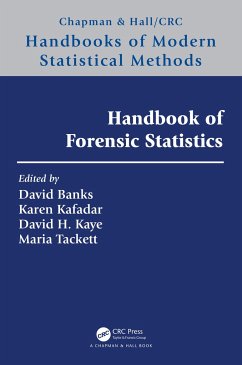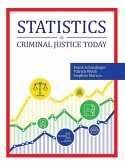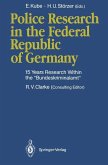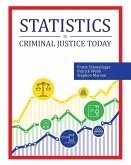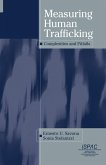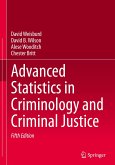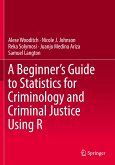Handbook of Forensic Statistics
Herausgeber: Banks, David L.; Kaye, David H.; Kafadar, Karen
Handbook of Forensic Statistics
Herausgeber: Banks, David L.; Kaye, David H.; Kafadar, Karen
- Gebundenes Buch
- Merkliste
- Auf die Merkliste
- Bewerten Bewerten
- Teilen
- Produkt teilen
- Produkterinnerung
- Produkterinnerung
Provides a definitive review of the state of best practice for statistical testimony across a wide range of the forensic sciences, including DNA and fingerprint matching, handwriting analysis, foot prints, eye witness identification, tool marks, bite marks, etc.
Andere Kunden interessierten sich auch für
![Analysis of sentences for sexual aggressions and abuses in Spain Analysis of sentences for sexual aggressions and abuses in Spain]() Juan Carlos Gómez MéndezAnalysis of sentences for sexual aggressions and abuses in Spain29,99 €
Juan Carlos Gómez MéndezAnalysis of sentences for sexual aggressions and abuses in Spain29,99 €![Statistics in Criminal Justice Today Statistics in Criminal Justice Today]() Frank SchmallegerStatistics in Criminal Justice Today217,99 €
Frank SchmallegerStatistics in Criminal Justice Today217,99 €![Police Research in the Federal Republic of Germany Police Research in the Federal Republic of Germany]() Police Research in the Federal Republic of Germany75,99 €
Police Research in the Federal Republic of Germany75,99 €![Statistics in Criminal Justice Today Statistics in Criminal Justice Today]() Frank SchmallegerStatistics in Criminal Justice Today157,99 €
Frank SchmallegerStatistics in Criminal Justice Today157,99 €![Measuring Human Trafficking Measuring Human Trafficking]() Ernesto U. Savona / Sophia Stefanizzi (eds.)Measuring Human Trafficking75,99 €
Ernesto U. Savona / Sophia Stefanizzi (eds.)Measuring Human Trafficking75,99 €![Advanced Statistics in Criminology and Criminal Justice Advanced Statistics in Criminology and Criminal Justice]() David WeisburdAdvanced Statistics in Criminology and Criminal Justice90,99 €
David WeisburdAdvanced Statistics in Criminology and Criminal Justice90,99 €![A Beginner's Guide to Statistics for Criminology and Criminal Justice Using R A Beginner's Guide to Statistics for Criminology and Criminal Justice Using R]() Alese WooditchA Beginner's Guide to Statistics for Criminology and Criminal Justice Using R45,99 €
Alese WooditchA Beginner's Guide to Statistics for Criminology and Criminal Justice Using R45,99 €-
-
-
Provides a definitive review of the state of best practice for statistical testimony across a wide range of the forensic sciences, including DNA and fingerprint matching, handwriting analysis, foot prints, eye witness identification, tool marks, bite marks, etc.
Produktdetails
- Produktdetails
- Verlag: Chapman and Hall/CRC
- Seitenzahl: 572
- Erscheinungstermin: 6. November 2020
- Englisch
- Abmessung: 260mm x 183mm x 35mm
- Gewicht: 1257g
- ISBN-13: 9781138295407
- ISBN-10: 113829540X
- Artikelnr.: 59997189
- Herstellerkennzeichnung
- Libri GmbH
- Europaallee 1
- 36244 Bad Hersfeld
- gpsr@libri.de
- Verlag: Chapman and Hall/CRC
- Seitenzahl: 572
- Erscheinungstermin: 6. November 2020
- Englisch
- Abmessung: 260mm x 183mm x 35mm
- Gewicht: 1257g
- ISBN-13: 9781138295407
- ISBN-10: 113829540X
- Artikelnr.: 59997189
- Herstellerkennzeichnung
- Libri GmbH
- Europaallee 1
- 36244 Bad Hersfeld
- gpsr@libri.de
David Banks is a professor in Department of Statistical Science at Duke University. He is a former coordinating editor of the Journal of the American Statistical Association, director of the Statistical and Applied Mathematical Sciences Institute, and a Fellow of the ASA and the Institute of Mathematical Statistics. Karen Kafadar is a Commonwealth Professor and the chair of the Department of Statistics at the University of Virginia. She is a former president of the ASA; a Fellow of the International Statistics Institute, the ASA and the AAAS; and a former member of the Forensic Science Standards Board (FSSB) of the Organization of Scientific Area Committees for Forensic Science (OSAC). David Kaye is Distinguished Professor of Law Emeritus at Pennsylvania State University and Regents' Professor of Law and Life Sciences Emeritus at Arizona State University. He is a former editor of Jurimetrics Journal; a member of the FSSB; and the 2020 recipient of the Association of American Law Schools' Wigmore Lifetime Achievement Award for contributions to the understanding of the proof process and the rules of evidence. Maria Tackett is an assistant professor of the practice in Department of Statistical Science at Duke University.
1. The history of forensic inference and statistics: a thematic
perspective. 2. Frequentist methods for statistical inference. 3. Bayesian
methods and forensic inference. 4. Comparing philosophies of statistical
inference. 5. Decision theory. 6. Association does not imply
discrimination: Clarifying when matches are (and are not) meaningful. 7.
Validation of forensic automatic likelihood ratio methods. 8. Bayesian
networks in forensic science. 9. How well do lay people comprehend
statistical statements from forensic scientists? 10. Forensic statistics in
the courtroom. 11. DNA frequencies and probabilities. 12. Kinship. 13.
Statistical support for conclusions in fingerprint examinations. 14.
Probabilistic considerations when interpreting data base search and
selection effects. 15. Comparing handwriting in questioned documents. 16.
An introduction to firearms examination for researchers in statistics. 17.
Shoeprints: the path from practice to science. 18. Forensic glass evidence.
19. Estimation of insect age for assessing minimum post-mortem interval in
forensic entomology casework. 20. Statistical models in forensic voice
comparison. 21. Bringing new statistical approaches to eyewitness evidence.
perspective. 2. Frequentist methods for statistical inference. 3. Bayesian
methods and forensic inference. 4. Comparing philosophies of statistical
inference. 5. Decision theory. 6. Association does not imply
discrimination: Clarifying when matches are (and are not) meaningful. 7.
Validation of forensic automatic likelihood ratio methods. 8. Bayesian
networks in forensic science. 9. How well do lay people comprehend
statistical statements from forensic scientists? 10. Forensic statistics in
the courtroom. 11. DNA frequencies and probabilities. 12. Kinship. 13.
Statistical support for conclusions in fingerprint examinations. 14.
Probabilistic considerations when interpreting data base search and
selection effects. 15. Comparing handwriting in questioned documents. 16.
An introduction to firearms examination for researchers in statistics. 17.
Shoeprints: the path from practice to science. 18. Forensic glass evidence.
19. Estimation of insect age for assessing minimum post-mortem interval in
forensic entomology casework. 20. Statistical models in forensic voice
comparison. 21. Bringing new statistical approaches to eyewitness evidence.
1. The history of forensic inference and statistics: a thematic
perspective. 2. Frequentist methods for statistical inference. 3. Bayesian
methods and forensic inference. 4. Comparing philosophies of statistical
inference. 5. Decision theory. 6. Association does not imply
discrimination: Clarifying when matches are (and are not) meaningful. 7.
Validation of forensic automatic likelihood ratio methods. 8. Bayesian
networks in forensic science. 9. How well do lay people comprehend
statistical statements from forensic scientists? 10. Forensic statistics in
the courtroom. 11. DNA frequencies and probabilities. 12. Kinship. 13.
Statistical support for conclusions in fingerprint examinations. 14.
Probabilistic considerations when interpreting data base search and
selection effects. 15. Comparing handwriting in questioned documents. 16.
An introduction to firearms examination for researchers in statistics. 17.
Shoeprints: the path from practice to science. 18. Forensic glass evidence.
19. Estimation of insect age for assessing minimum post-mortem interval in
forensic entomology casework. 20. Statistical models in forensic voice
comparison. 21. Bringing new statistical approaches to eyewitness evidence.
perspective. 2. Frequentist methods for statistical inference. 3. Bayesian
methods and forensic inference. 4. Comparing philosophies of statistical
inference. 5. Decision theory. 6. Association does not imply
discrimination: Clarifying when matches are (and are not) meaningful. 7.
Validation of forensic automatic likelihood ratio methods. 8. Bayesian
networks in forensic science. 9. How well do lay people comprehend
statistical statements from forensic scientists? 10. Forensic statistics in
the courtroom. 11. DNA frequencies and probabilities. 12. Kinship. 13.
Statistical support for conclusions in fingerprint examinations. 14.
Probabilistic considerations when interpreting data base search and
selection effects. 15. Comparing handwriting in questioned documents. 16.
An introduction to firearms examination for researchers in statistics. 17.
Shoeprints: the path from practice to science. 18. Forensic glass evidence.
19. Estimation of insect age for assessing minimum post-mortem interval in
forensic entomology casework. 20. Statistical models in forensic voice
comparison. 21. Bringing new statistical approaches to eyewitness evidence.

